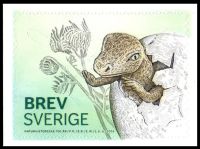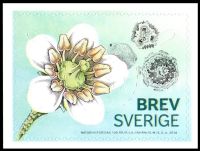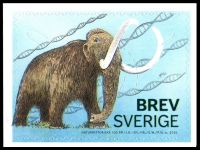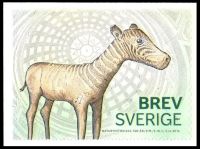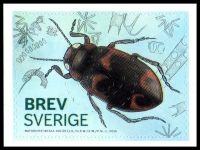Sweden 2016 "Animals and plants from the Palace of Nature"
| <prev | back to index | next> |
| Issue Date | 14.01.2016 |
| ID | Michel: Scott: Stanley Gibbons: Yvert: UPU: N/A Category: pR |
| Author | Eva Wilsson, Lars Sjööblom (E), Piotr
Naszarkowski (E) |
| Stamps in set | 5 |
| Value | BREV = Domestic letter of 20gr Maiasaura flower Queen Silvia Mammoth Quagga Hydroporus figuratus |
| Size (width x height) | 36.6x26.5 mm |
| Layout | booklet of 10 stamps |
| Products | FDC x1 MC x5 |
| Paper | |
| Perforation | none |
| Print Technique | Offset, 4 colours |
| Printed by | |
| Quantity | N/A |
| Issuing Authority |
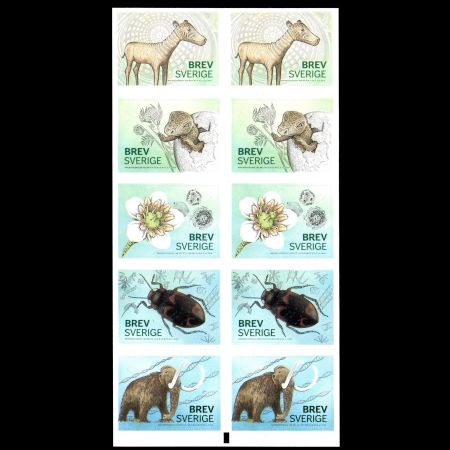
On January 14, 2016 Post Authority of Sweden issued a set of 5 stamps: Animals and plants from the Palace of Nature". Stamps issued in a booklet of 10. The Swedish Museum of Natural History celebrate its centennial in the building that is sometimes called the Palace of Nature. It is home to the outcome of the curiosity and thirst for knowledge demonstrated by men and women throughout the years.
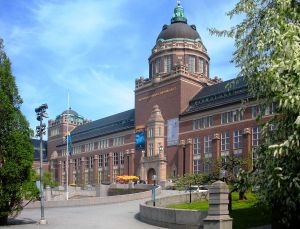 The decision to construct the building that would house the Swedish Museum of Natural History
in Frescati (Inspired by his trip to Italy in the 1780s, King Gustaf
III named several areas in northern Stockholm after places in Italy) in
northern Stockholm was made in 1901. The idea was that Frescati would
become a center of science, and the museum a jewel in the crown of the
Royal Swedish Academy. The museum and several other buildings were
constructed over the period 1907–1916 based on drawings by architect
Axel Anderberg, who also designed the Royal Swedish Academy’s building.
The museum’s main building was built to be a monument and has its roots
in the Baroque period as well as powerful, geometric Art Nouveau. The
facades were dressed in dark red brick. The wings that extend from the
main building were initially home to the museum’s departments at that
time, zoology, paleontology
and geology. The botanical department was given a separate building. In
its early days, the museum did not have electric lighting and the
buildings were therefore equipped with large, tall windows to allow
daylight to shine on the exhibitions. Over the years, the Swedish
Museum of Natural History has been expanded via underground chambers to
store its extensive collections. Cosmonova, the museum’s combined
planetarium and domed movie theater, was opened in 1992 in a separate
building connected to the main building.
The decision to construct the building that would house the Swedish Museum of Natural History
in Frescati (Inspired by his trip to Italy in the 1780s, King Gustaf
III named several areas in northern Stockholm after places in Italy) in
northern Stockholm was made in 1901. The idea was that Frescati would
become a center of science, and the museum a jewel in the crown of the
Royal Swedish Academy. The museum and several other buildings were
constructed over the period 1907–1916 based on drawings by architect
Axel Anderberg, who also designed the Royal Swedish Academy’s building.
The museum’s main building was built to be a monument and has its roots
in the Baroque period as well as powerful, geometric Art Nouveau. The
facades were dressed in dark red brick. The wings that extend from the
main building were initially home to the museum’s departments at that
time, zoology, paleontology
and geology. The botanical department was given a separate building. In
its early days, the museum did not have electric lighting and the
buildings were therefore equipped with large, tall windows to allow
daylight to shine on the exhibitions. Over the years, the Swedish
Museum of Natural History has been expanded via underground chambers to
store its extensive collections. Cosmonova, the museum’s combined
planetarium and domed movie theater, was opened in 1992 in a separate
building connected to the main building. The museum is Sweden’s largest, and it contains more than ten million fossils, animals, plants, fungi and minerals. The stamp motifs depict a representative sample from the collections.
Products and associated philatelic items
| FDC *EUROPA 2016 - Think Green stamp (issued on the same day) includen on FDC, Collector's Sheet and Maxi Cards set |
|
| Official FDC (used one can be seen here and inside text here) | FDC signed by stamp designers: Eva Wilsson Lars Sjööblon |
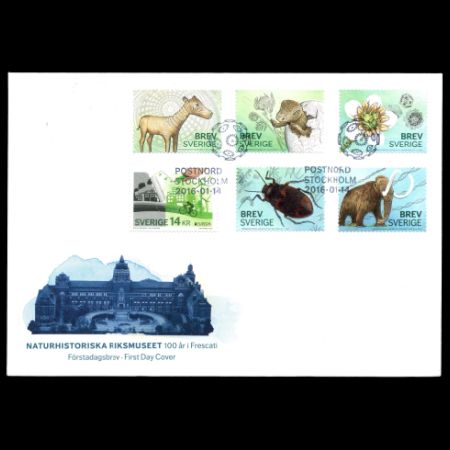 |
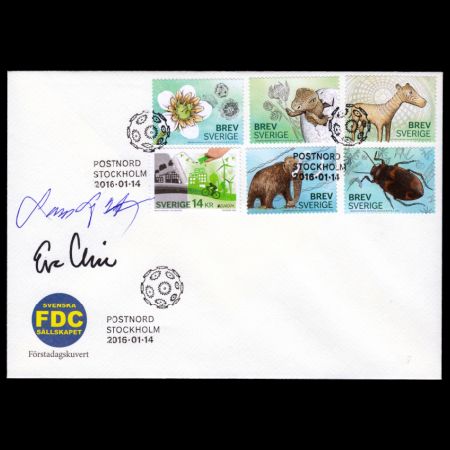 |
| Covers sent on the stamps issue date | |
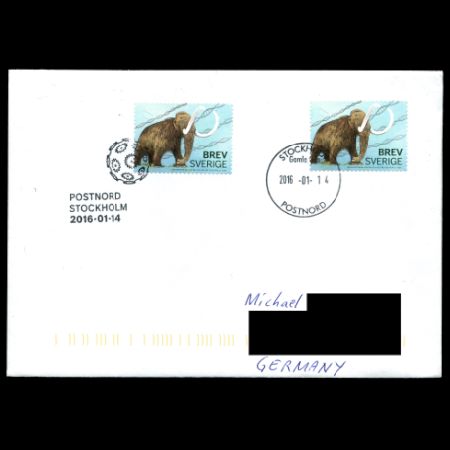 | 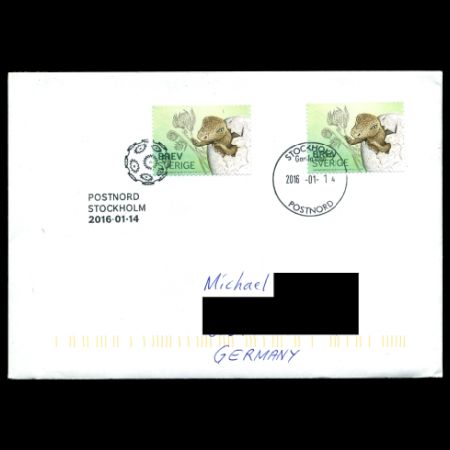 |
| Collector's Sheet | The booklet |
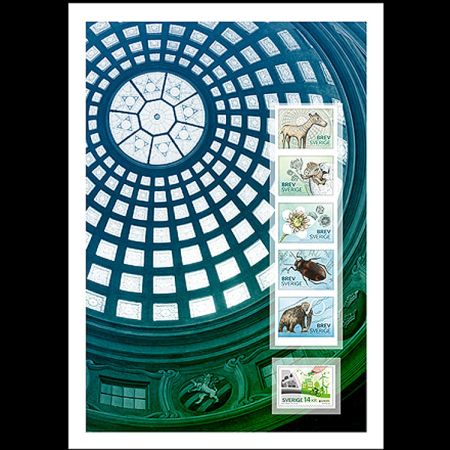 |
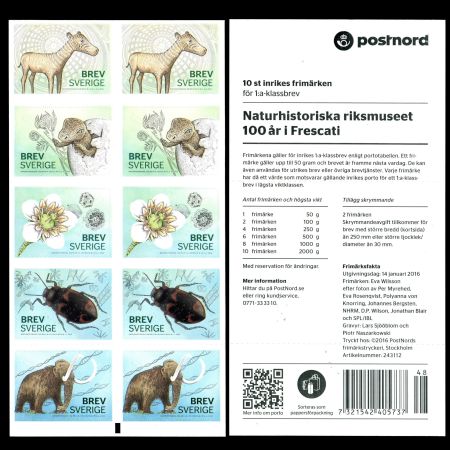 |
| Maxi Cards | |
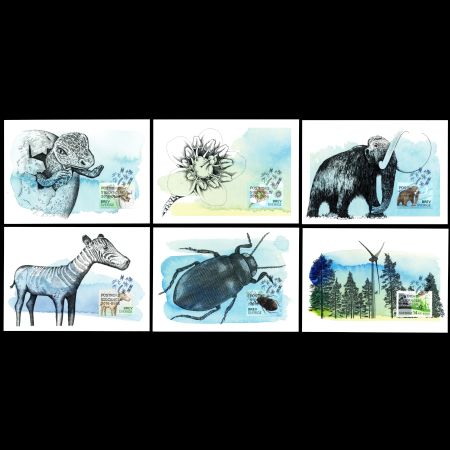 | |

|
References
Bulletin (Stamp News magazine)| <prev | back to index | next> |
Last update 10.12.2017
Any feedback, comments or even complaints are welcome: admin@paleophilatelie.eu (you can email me on ENglish, DEutsch, or RUssian)
